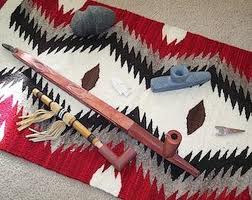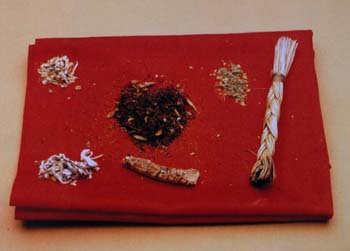
Calumet or Pipe has many names and traditions from the Salish of the pacific northwest, to the Six Nations in the northeast, the Dine'and Tlingit of the north, the Cherokee in the southeast and the Tarahumara, south of the border: the pipe has been a symbol of prayer and ceremony to all our Native American people for thousands of years. It is a physical link between the Creator-The Great Spirit and the ancestral teachings. It has been a part of Plains culture since time immemorial as means of Prayer, Transformation, and Connection to the Great Mysteries.
Some call a pipe, a peace pipe, from the role it has played in important ceremony’s between nations and families at times of conflict and distress. There are many styles of pipe and designs though most are used in a similar fashion. The two main categories of pipes are personal and ceremonial pipes; the distinction being that a ceremonial pipe often came into being to serve the greater community, whereas a personal pipe is just that. Both serve as a way of living and supporting the culture.
Pipes by any name, have always been the very symbol of peace and harmony, reminding use of our connection to all living things and our unity of Body, Mind, Spirit, and Nation. As we continue this discussion, when we say "pipe" we mean a ceremonial pipe versus a personal pipe.

It is important for this reason that a ceremonial pipe not be taken lightly. It is in fact a heavy burden to carry, because it is not only for oneself, but also for the many peoples and the many generations to come as much as the ancestral linage from whence it has come into being to support. A ceremonial pipe has the added responsibility of caring for the many nations and powers from which it has been called by the Great Spirit to support.
All pipe carriers believe not only in the sacredness of these pipes and its many medicines but also in the living spirit within the pipe. Great care is taken to protect the traditional pipes, which are often hundreds of years old and carry with them the colour and teachings of their Nation. Such protection is not just the physical but also all the spiritual and emotional well being of the pipe and peoples whom would have contact with it.
This duty includes gathering and keeping appropriate herbal and ceremonial items. Healing and praying for others, and carrying the pipe to ceremonial gatherings, and people whom might have need of its aid. Often pipe carriers can be expected to be called great distances because they are called to do the work by the Great Spirit. It is believed that most pipes choose their carriers and have a way of willing themselves to their great purpose.
There are many differing views and culture around Pipe use and ceremonies, below are some guidelines to help prepare oneself for a pipe gathering and/or ceremony.

Pipe Gatherings:
Pipe gatherings and ceremonies are called to provide community an opportunity to come togther and share in the teachings and benefits of pipes being gathered. Often a pipe gathering is requested and sponsored by a family or community and like many great mysteries other are called to attend. It is not uncommon for one or two carriers to arrive and discover other, unannounced, carriers whom happen (synchronicity) to have also arrived.
At the beginning of each gathering, Protocol for each pipe is often shared by its carriers, as many pipes have different preferences and guidance is offered though the process. One can often expect signs of the ceremonies' influences in the environment. Many will report personal changes, both immediately after the ceremony and again, often months after.
Typical expectations at a pipe ceremony:
1> Bring a small gifting for the pipe carrier to ease their journey
2> Bring an offering for the pipe such as a natural plant, home grown tobacco, herbs, medicines, or other tools and/or items that might be of use
3> Come with clear intentions and prayers for yourself and others
4> Come cleansed of toxins and harmful elements that might impede the experience (such as alcohol, drugs or chemicals)

5> If given the opportunity to handle a pipe do so gentle and softly supporting the stone base with one hand and the other on the stem
6> Remember the living spirit of the pipe is often ancestral use words and expression which would nurture and support the elderly with respect and kindness to all.
7> There are many views on the participation of women in the pipe cermony, including moon time and not touching certain pipes--make sure you have received clear instructions from the pipe ceremony Elders and carriers on such topics.
Typical Ceremony:
1> cleansing of the space and our bodies with smudge
2> prayers for the sacred and words of welcoming
3> introductions and shared intentions
4> loading of the pipe with prayers (each is expected to be quietly reflecting or praying)
5> passing of the pipe/s (each having their short time to hold and pray with the pipe)
6> sharing of stories and teachings
7> closing words and guidance and prayers
